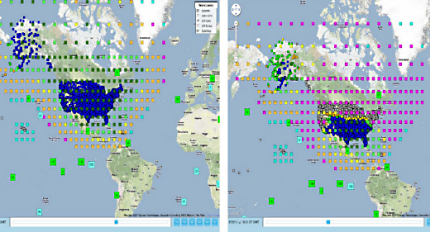Navy tracks how solar events can disrupt satellite navigation
Coronal mass ejections can affect WAAS and other electronic systems in wide-ranging ways.

An FAA image shows WAAS accuracy before and after the Sept. 26, 2011 disturbance. Blue symbols indicating normal operations abound on Sept. 25 (left) but the next day reveals degraded signals in the northern continental U.S. and Alaska.
While satellites in orbit have to contend with a variety of manmade dangers, such as debris or intentional jamming and attack, one threat is native to operating in space: ionospheric disturbances.
To better understand the origins of those disturbances, Naval Research Lab scientists have been analyzing coronal mass ejections and their effect on ground-based global navigation systems, according to a NRL release.
Dr. Brian Wood of NRL’s Space Science Division has focused on two particularly strong ionospheric disturbances that happened on Sept. 26 and Oct. 24, 2011.
On those two days, the accuracy of the Federal Aviation Administration’s Wide Area Augmentation System was severely degraded. WAAS is designed to provide extremely accurate navigation for civil aviation, and uses a system of ground stations to correct standard Global Positioning System signals, according to the FAA. WAAS is capable of guiding landing approaches because of its high accuracy.
Using NRL-designed imagers on NASA STEREO and SOHO satellites, both of which are designed to monitor solar activity, Wood was able to attribute the cause of the disturbances to two coronal mass ejections that occurred two days prior to the disruptions.
CMEs are a large burst of matter and electromagnetic radiation from the sun’s surface into space. When pointed in the direction of Earth, they can bring detached magnetic loops and charged particles that can interfere with the Earth’s magnetic field and cause variations in the ionosphere that can adversely affect GPS signals.
Wood was able to create three-dimensional structures and kinematics detailing the mechanics of the CMEs. The September CME is determined to have reached a maximum speed of 1,700 kilometers per second and made a glancing hit on Earth from the shock of the ejection, according to the release. The October CME traveled at 700 kilometers per second but hit the Earth more directly.
CMEs represent an interesting problem for researchers because they are difficult to predict, and have wide-ranging effects. A particularly large solar flare that occurred in 1859, also known as the Carrington Event, resulted in telegraph systems shocking operators and setting paper on fire, according to NASA. The 1989 geomagnetic storm that blacked-out Quebec was the result of an CME.
A similar event occurring today could have farther reaching consequences, because of increased reliance on electronics for telecommunications, navigation and power. Wood is hoping that his research could help predict future solar events that could affect critical systems.
"The ultimate goal is to be able to predict in advance the effects of a solar storm on communications and navigation at Earth,” Wood said. “Characterizing the sources of geoeffective solar storms is a necessary step in that direction."


